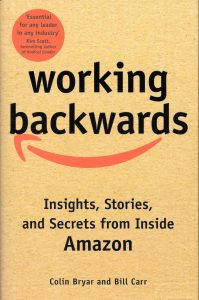The one sentence summary
Success is not achieved by the genius of any one leader, but through commitment to a set of well-defined and rigorously executed principles and practices.
Can’t be bothered to read it? Too much screen time lately? Listen to the 5-minute podcast in two parts.
WHAT THE BOOK SAYS 
- This book contains insights, stories and secrets from inside Amazon.
- Since the early days, the company has stood by 4 core principles: obsess over customers, it’s all about the long term, we will continue to learn from both our successes and failures, and operational excellence. These led to a series of 14 leadership principles.
- Customer obsession: start with the customer and work backwards.
- Ownership: leaders act on behalf of the whole company.
- Invent and simplify: look for new ideas from everywhere.
- Are right, a lot: leaders have strong judgment and good instincts.
- Learn and be curious: you never stop learning.
- Hire and develop the best: raise the performance bar with every hire.
- Insist on the highest standards:
- Think big: thinking small is a self-fulfilling prophecy.
- Bias for action: speed matters in business.
- Frugality: accomplish more with less.
- Earn trust: listen attentively and speak candidly.
- Dive deep: operate at all levels and stay connected.
- Have backbone; disagree and commit – discuss, then commit wholly.
- Deliver results: be accountable.
WHAT’S GOOD ABOUT IT
- For agility and speed, teams should be two-pizza teams – no larger than the number of people who could be fed by two large pizzas. This only works well in product development – less so elsewhere.
- Powerpoint was banned and replaced with the six-pager – a properly thought-through briefing paper. At the beginning of every meeting, everyone reads this in silence for 20 minutes, then the discussion begins. When reading it, you should always assume that every sentence is wrong and subject it to full scrutiny.
- The bar raising process has 8 elements: job description, resumé review, phone screen, in-house interview, written feedback, debrief/hiring meeting, reference check, offer through onboarding.
- The interview STAR process stands for Situation, Task, Action, Result. “What was the situation?” “What were you tasked with?” “What actions did you take?” “What was the result?”
- They tried implanting fitness functions – a weighted series of metrics to assess success – but it didn’t work because no one could agree on what they were.
- Be stubborn on the vision, but flexible on the details
- The working backwards document became known as the PR/FAQ. This involves writing the press release: name the product in the way a customer will understand, describe the benefits, identify a problem and explain how the product provides a solution to it. The FAQ answers questions on consumer needs, the Total Addressable Market (TAM) and the economic opportunity.
- In the flywheel, input metrics lead to output metrics and back again. Better customer experience = more traffic = more sellers = wider selection = enhanced customer experience = growth = lower cost structure = improved customer experience.
WHAT YOU HAVE TO WATCH
- In truth, these principles could be expressed in a short paper rather than a book (the second half of the book contains examples of specific Amazon products such as Kindle, Prime and Prime Video).
